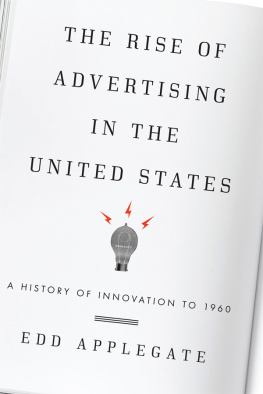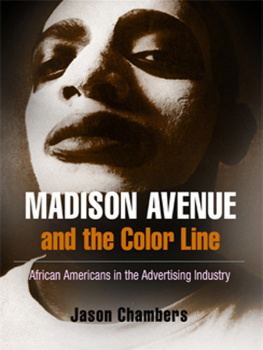The Rise of Advertising in the
United States
A History of Innovation to 1960
Edd Applegate

THE SCARECROW PRESS, INC.
Lanham Toronto Plymouth, UK
2012
Published by Scarecrow Press, Inc.
A wholly owned subsidiary of The Rowman & Littlefield Publishing Group, Inc.
4501 Forbes Boulevard, Suite 200, Lanham, Maryland 20706
www.rowman.com
10 Thornbury Road, Plymouth PL6 7PP, United Kingdom
Copyright 2012 by SCARECROW PRESS
All rights reserved. No part of this book may be reproduced in any form or by any electronic or mechanical means, including information storage and retrieval systems, without written permission from the publisher, except by a reviewer who may quote passages in a review.
British Library Cataloguing in Publication Information Available
Library of Congress Cataloging-in-Publication Data
Applegate, Edd.
The rise of advertising in the United States : a history of innovation to 1960 / Edd Applegate.
p. cm.
Includes bibliographical references and index.
ISBN 978-0-8108-8406-9 (cloth : alk. paper) ISBN 978-0-8108-8407-6 (ebook)
1. AdvertisingUnited StatesHistory. I. Title.
HF5813.U6A733 2012
659.10973dc23
2012018903
 The paper used in this publication meets the minimum requirements of American National Standard for Information Sciences Permanence of Paper for Printed Library Materials, ANSI/NISO Z39.48-1992.
The paper used in this publication meets the minimum requirements of American National Standard for Information Sciences Permanence of Paper for Printed Library Materials, ANSI/NISO Z39.48-1992.
Printed in the United States of America
This book is for Eva, Judy, and Carolyn.
Acknowledgments
Numerous individuals at colleges and universities, advertising agencies, corporations, and organizations provided valuable resources while I was researching and writing this book.
I wish to thank the librarians at the James E. Walker Library, Middle Tennessee State University, for their assistance in obtaining specific articles and books. I wish to thank the librarians at the following libraries for their help: Felix G. Woodward Library at Austin Peay State University, Lila D. Bunch Library at Belmont University, Stephens-Burnett Memorial Library at Carson-Newman College, Charles C. Sherrod Library at East Tennessee State University, Hartzler Library at Eastern Mennonite University, Eli M. Oboler Library at Idaho State University, University Library at the University of Illinois Urbana-Champaign, The Kansas City Public Library, Library of Congress, A. R. Wentz Library at the Lutheran Theological Seminary at Gettysburg, Murray Library at Messiah College, Nashville Public Library, Pius XII Memorial Library at Saint Louis University, St. Louis Public Library, Martha M. Brown and Lois H. Daniel Memorial Library at Tennessee State University, Angelo and Jennette Volpe Library at Tennessee Technological University, Waggoner Library at Trevecca Nazarene University, Burke Theological Library at Union Theological Seminary, J. D. Williams Library at the University of Mississippi, Bizzell Memorial Library at the University of Oklahoma, Thomas Cooper Library at the University of South Carolina, Lupton Library at the University of Tennessee at Chattanooga, Health Sciences Library and Biocommunications Center at the University of Tennessee Health Science Center, John C. Hodges Main Library at the University of TennesseeKnoxville, and the Worcester (Massachusetts) Public Library.
I wish to thank the staff at the Historical Society of Pennsylvania for providing valuable information. I wish to thank the director of the P. T. Barnum Museum, Bridgeport, Connecticut, for information about P. T. Barnum.
I wish to thank the executives of Procter & Gamble (P&G), Cincinnati, Ohio; the executives of Springs Industries, Inc. (Springs Global), Fort Mill, South Carolina; and the executives of the former N. W. Ayer & Partners advertising agency, New York, for their kind responses to my inquiries (N. W. Ayer & Partners advertising agency merged into the Kaplan Thaler Group).
Finally, I wish to thank my editor and the other wonderful people at Scarecrow Press who worked on this book.
Introduction
This book examines several fascinating individuals who were responsible for building or growing businesses, including advertising agencies, from the earliest days in the United States to the second half of the twentieth century. Each chapter focuses on one or more personalities who worked in a particular business and either employed advertising to promote the business and product or produced advertising that helped sell clients products and services. In some instances, some of these individuals not only earned considerable fortunes but contributed greatly to advertisings development.
The first chapter discusses printers who published newspapers and magazines in the American colonies. The discussion focuses primarily on the differences among the printers, their respective newspapers or magazines, and, of course, the advertisements they accepted for publication. Several examples of these advertisements are included and discussed.
The second chapter examines three of the first advertising agentsincluding Volney B. Palmer, George P. Rowell, and Francis Wayland Ayer, who founded N. W. Ayer and Sonand focuses on their contributions to the development of advertising as a business.
The third chapter examines P. T. Barnums professional career, especially the innovative contributions that he made to advertising and marketing. Barnum, a master salesman, employed outdoor advertising and promotion, among other forms, to announce his attractions. In addition, he manipulated publishers and editors of newspapers into running stories about his upcoming shows.
The fourth chapter discusses Lydia E. Pinkham, one of the first women in the United States to establish a successful business as a result of using advertising effectively. Her Lydia E. Pinkhams Vegetable Compound was one of the most popular patent medicines of its day. This chapter also discusses the journalistic campaign against patent medicines, including Pinkhams vegetable compound, as well as the problems that the Lydia E. Pinkham Medicine Company experienced under the guidance of Pinkhams heirs in the twentieth century.
The fifth chapter examines John Wanamaker, a retailer who learned about the American consumer a century before Sam Walton, the founder of Wal-Mart. However, few realize that in addition to being an astute businessman, Wanamaker was one of the first major department store owners to understand the power of advertising. Indeed, the advertisements that appeared in newspapers not only informed consumers about articles of clothing but guaranteed their quality. Wanamaker also advertised the policy of money back. He was the first retailer to place a full-page newspaper advertisement in the United States. In addition to using newspapers, he advertised outdoors and on specialty items, such as pencils and balloons. Before he retired in the early twentieth century, he had built one of the largest department stores in the country.
The sixth chapter focuses on Albert Lasker and the Lord & Thomas Advertising Agency, which Lasker eventually owned. It also discusses the contributions that Lasker and the agency made to advertising.
The seventh chapter examines the first 100 years of Procter & Gamble, as well as the advertising of what eventually became its best-selling product at the time, Ivory Soap. Specifically, this chapter discusses the founding of the company by William Procter and James Gamble, as well as the development and advertising of Ivory Soap from the 1880s to the 1930s. Part of the discussion focuses on Harley Procter, who advertised successfully Ivory Soap, and William Cooper Procter, who introduced several revolutionary concepts into the daily management of the company.













 The paper used in this publication meets the minimum requirements of American National Standard for Information Sciences Permanence of Paper for Printed Library Materials, ANSI/NISO Z39.48-1992.
The paper used in this publication meets the minimum requirements of American National Standard for Information Sciences Permanence of Paper for Printed Library Materials, ANSI/NISO Z39.48-1992.